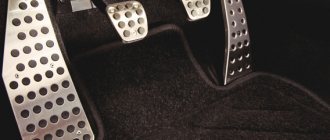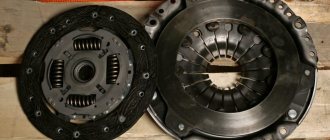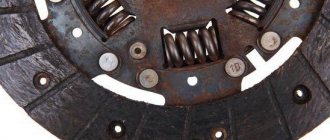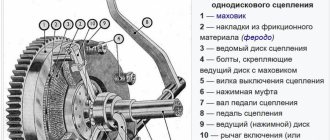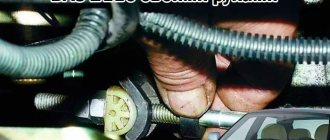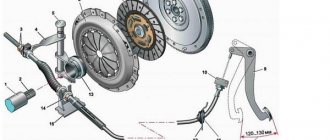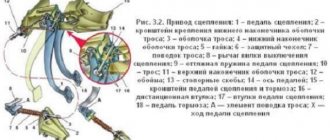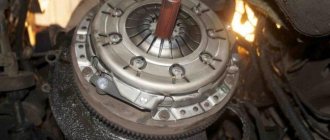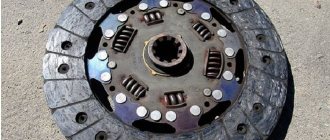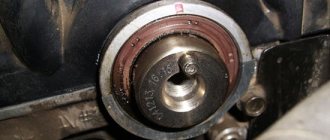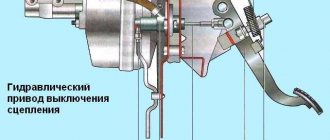During operation, the car inevitably breaks down. Sometimes this happens extremely unexpectedly, falling on the driver literally out of the blue. The clutch transmits engine torque to the wheels through the transmission. If it fails, the car simply will not be able to fully move or even move.
You can survive when the clutch fails within a populated area. It’s more difficult if the car refuses to drive on the highway or far from civilization. But even in such circumstances there is a solution. The main thing is not to panic.
When it's dangerous to drive
During operation, the clutch driven disc necessarily wears out. The intensity of this phenomenon directly depends on driving style. With careful driving, its service life can be 120,000 kilometers.
While driving, it is important for every driver to perceive the signals that the clutch gives and react to them correctly.
Motorists should be alert to the following phenomena:
- clutch slip;
- jerks during its operation;
- extraneous noise when shifting gears;
- the mechanism cannot be released.
This occurs due to fractures of the support bearing, friction linings, and wear of the synchronizer rings. An unexpected critical breakdown is almost always the result of driver inattention. If you ignore the symptoms described above, this will lead to the need to replace the entire clutch basket.
There are circumstances in which it is simply unacceptable to continue driving a car. This cannot be done in the following situations:
- when “jamming” in reverse or high gear;
- on a steep climb or descent;
- in case of instability at work;
- with strong shaking, vibrations, “crunching” at the moment of gear shifting.
What happens if you change gear without a clutch?
Naturally, there is no need to practice this constantly without doing anything. And you are unlikely to be able to do this intentionally and easily. A difficult task. Because the driver will encounter such serious vibration on the lever that it will immediately become clear that it’s time to end such experiments.
Still, let's not forget that gears and rims are products made of alloy steel. A person does not have much strength to “defeat” them. There is definitely a small chance that the teeth will be able to match, resulting in a gear change. But the chances of this are very small. The most important thing here is the moment of engagement of the lever with the gear. But he doesn’t exist, as you understand.
Ways to Keep Moving
The causes of the malfunctions described above are oiling, damage to the lining of the driven disk, as well as its deformation. In addition, jamming of the fork, bearings, pressure plate, and deformation of the flywheel can cause problems.
If the clutch fails at the most unexpected moment on a deserted section of the road, then do not despair. Even when the car has stopped, but there are several people in the cabin, it can always be started “from the pusher”. Unfortunately, there are situations when a motorist finds himself alone with such problems. Even in the most critical situations, do not despair. Experienced motorists offer their solutions.
From first gear
Even under such circumstances, you can get out of the situation with dignity. Here you need to proceed as follows:
- with the engine turned off, you need to engage first gear;
- gently press the accelerator pedal while turning the key inside the ignition switch;
- smoothly drive to the nearest town.
According to experienced drivers, during such a drive you can switch to higher gears. It is important to do this as smoothly as possible, without sudden movements.
Shift gears
If the left pedal completely fails while driving, then do not panic:
- Under such circumstances, you need to alternately reduce the speed, switching the manual transmission lever to lower positions.
- If the clutch fails while the gear is engaged, you need to release the gas and move the gear lever to neutral. In this case, you need to periodically “gas” it.
- After a slight acceleration, it is recommended to press the manual transmission lever as if changing gears.
- After this, release pressure on the accelerator pedal. Under such conditions, the lever will completely return to its natural position.
How to get there without a clutch?
Details Category: Driving school Published 10/09/2014
It often happens in the life of motorists that the car is left without a clutch . This is most often due to such trivial reasons as a broken clutch cable or a leak in the clutch hydraulic drive.
However, it is not always possible to eliminate such malfunctions on your own along the way. Therefore, the way out of this situation is to look for a tug or tow truck to get to the repair site. However, if there is no one to help you, it’s not a problem, and without a clutch it’s quite possible to drive a car. The algorithm of actions is below.
1. With the car turned off, engage first gear.
2. Turn on the ignition and start the engine. At the same time, due to the fact that the car is in gear, it will begin to jerk forward. At this moment, smoothly press the gas and release the ignition key so that the starter turns off.
3. That's it, the car is slowly moving without a clutch.
4. To engage second gear, accelerate the car a little and sharply remove your foot from the gas pedal. Simultaneously with releasing the gas pedal, move the gearshift lever to the neutral position. To turn on the second speed, we gradually begin to turn it on. If the speeds of the shafts in the gearbox and the movement of the car coincide, then it will turn on without problems. If the gearshift lever resists turning on, you need to wait a little and try again.
Attention! If you feel resistance to the gearbox lever, it means that the speeds of the car and the shafts in the gearbox are not yet equal; you should not try to force the gearbox, as you can damage the gearbox parts.
5. Having accelerated a little, you can also engage third gear, but it is better to move carefully in the first two gears.
6. If you need to engage a lower gear, this should only be done with a re-throttle, so as not to damage the gearbox.
Don't forget to turn on your hazard lights and be careful not to disturb others. Thus, you can get used to it and move quite long distances without harm to the car. For example, most drivers of American tractors, which are traditionally equipped with non-synchronized manual transmissions, use the clutch only when starting to move, and during the process they shift without using the clutch, intuitively feeling the shift moments and using the throttle.
conclusions
Experienced drivers recommend depressing the clutch pedal on cars with manual transmissions before starting the engine, which helps start the engine, even if there are problems with the battery and generator. On older cars, such a procedure could lead to wear of the release bearing, but on new cars this problem is completely solved. In particular, depressing the clutch pedal in this way helps in the winter, when the starter and battery are under increased load, simultaneously preventing increased engine wear.
Depressing the clutch when starting the engine: all the pros and cons
As a rule, the habit of squeezing the clutch before starting the engine for many drivers who drive a car with a manual transmission is an action that has been brought to full automaticity. The clutch is always depressed, regardless of the time of year, the degree of engine warm-up, etc.
At the same time, although less often, there are car owners who categorically do not recommend constantly depressing the clutch pedal before starting the engine. Let's consider the arguments of one and the other side.
- Let's start with the supporters of the squeeze. Without going into technical details, by pressing the clutch pedal, the driver completely “opens” the gearbox and the engine.
It is for this reason that those who have been accustomed to driving cars since the times of the USSR are well aware that it is easier for a starter with the clutch depressed to turn the crankshaft, since the input shaft in the box does not rotate when the clutch is depressed.
Taking into account the fact that carburetor cars themselves often experience certain difficulties with starting (especially when cold), it becomes clear why you need to depress the clutch when starting the engine on such cars.
Now about more modern vehicles with a manual transmission. Quite often, the need to depress the clutch before starting the engine is dictated by the fact that on some European and American-made cars the power unit simply will not start without such an action.
This solution allows you to increase safety during operation, especially when it comes to novice drivers. In other words, if the owner does not yet have a clearly developed habit of removing the transmission from gear after parking the vehicle and shifting the gearbox to neutral, then depressing the clutch pedal avoids the risks of starting the internal combustion engine with the gear engaged.
In fact, it eliminates the possibility that the car will jerk when starting from the starter, which can cause certain troubles. It turns out that clutch release plays the role of a kind of protection, insuring a forgetful or inexperienced driver.
The next argument is directly related to the design feature. If you start the engine, especially when it is cold, without pressing the clutch, the battery charge is consumed faster, the load on the starter increases, etc. We have already said above that if the clutch pedal is not depressed, then at the moment of starting it will be necessary to turn the gearbox input shaft.
If you imagine that the engine oil is thick in winter, add to this even more viscous lubricant in the gearbox, and also take into account the fact that in the cold season the battery naturally holds its charge worse and consumes more charge, then the need to depress the clutch is also quite obvious.
Why and when it is not recommended to squeeze the clutch before starting the internal combustion engine
Now let's consider the statements of opponents who firmly believe that there is no need to squeeze the clutch before starting the engine.
The main argument is that squeezing the clutch can harm the power unit and reduce its service life.
More precisely, we are talking about the crankshaft thrust bearing. If the clutch is depressed at the moment of starting the internal combustion engine, then the said bearing is subjected to significant loads for which it was not originally designed.
Moreover, under such a load, this element has to work for some time under dry friction conditions (without oil). The fact is that the lubricating fluid, especially thick ones, does not reach it immediately.
We also recommend reading the article about what engine speed is best to drive at. From this article you will learn about what speeds are best to keep on gasoline and diesel cars to preserve engine life without compromising dynamics.
The result is a significant reduction in the service life of the element, the crankshaft itself receives axial play, then increased vibrations appear, which are then transmitted to the body. The result is that the engine needs to be disassembled, since the motor is in urgent need of repair.
Taking into account the above information, this group of car owners focuses on the fact that it may be necessary to squeeze the clutch before starting, but only under certain conditions. These include a strong drop in outside temperature when the oil in the internal combustion engine and gearbox is very thick.
In such conditions, it is initially more important to successfully start the engine rather than think about the bearing life. However, if there are no prerequisites for squeezing, then you should not press the clutch pedal before starting the internal combustion engine.
How to drive without a clutch
In the first part, we discussed what to do if the clutch cable breaks along the way.
The second part of the quest is to get from the parking lot to the service station or home. The rules are similar.
Here they are: 1. It is better to drive at night or early in the morning , when traffic on the roads is light. 2.Before starting to drive, start in neutral and warm up the engine to operating temperature. This is necessary so that the engine does not stall when we pull away in first gear. 3. Before we start moving, we clearly plan the route . “I’ll turn left, then I’ll turn right onto Surganov and stay in the right lane, then I’ll turn right onto Bogdanovich on Bangalore, staying in the right lane,” etc. It is advisable to think through each intersection and, if possible, avoid busy streets and traffic lights. This is why it is better to complete this quest late in the evening. 4. When planning your route, try to always take the main road . Since there is no clutch, it is advisable not to stop while driving. And if you drive on the secondary road, you will have to stop and give way at the intersection. I had 3 intersections with the main one: exit to Surganov from the courtyards, turn left from Nekrasov to Kolas and turn left in my native Borovlyany. 5. If the route starts from an exit from a secondary road, then make sure in advance that the main road is clear. If the main one is busy, wait a little until she is free. Let's arrange it so that it is free when we slowly roll up to it in first gear. 6. Well, let's start? Fuck it. Buckle up! 7. Well, now let's go! But no. Turn on the emergency lights! 8. Okay, we're ready. We set off the same way as before. We turn on the first one, turn the key and give the gas (no, no need to fart, it won’t help the grief). That's it, let's go first. 9. You will have to drive very slowly in first gear. Even at 20 km/h the engine will roar indignantly. Therefore, there is an option to enable the second one. To do this, we will drive on the first for a few minutes to ensure that the battery is charged. It will be difficult for him to turn the starter to start from second gear. Ready for second gear? Here's how to turn it on: 10. If possible, stop on a descent, or at least on a flat area. Not on the rise ! 11. Without starting the engine, turn on second gear , and then repeat the same shamanism as before. We do not spare the gas so that the engine pulls out of second gear. The engine will snort once, twice, three times and start. It will be harder to get going than with the first one. 12. The second one is much more pleasant to drive. You can accelerate to 40 km/h - and this is almost normal city speed. 13. in advance and plan the movement so that we don’t have to stop. Do you see the pedestrian? Slow down in advance and let him pass. Traffic light? Roll as slowly as possible to miss the red and hit the green. (I failed to calculate once, and I ran a red light very hard...) 14. If you had to stop at a traffic light, we start from the first one. It is advisable to plan it so that you have to start the engine only once and immediately drive through the intersection without additional stops. 15. That's all. So we'll slowly drive home. If you park, position yourself so that next time you still have the opportunity to move (don’t put your nose in the farthest corner).
And finally - the main thing. 1. while driving! You will damage the box! 2. If you stop on the rise , you won’t be able to move and you’ll lose your battery! Stand only on a descent or on a flat area. 3. Before starting the car, warm up the engine. If you can't get going, you'll drain the battery! 4. When driving without a clutch, it is very important in advance and calculate the road situation in advance. 5. Try to drive only on the main road so as not to give way. 6. Did you know that instead of turning left, you can turn right 3 times? 7. Are you getting ready to stop? Plan how you will start moving later.
Sources
- https://cardinator.ru/mozhno-li-perekljuchat-peredachi-bez-sceplenija-i-chto-budet-esli-perekljuchit-peredachu-bez-sceplenija/
- https://ru.wikihow.com/%D0%BF%D0%B5%D1%80%D0%B5%D0%BA%D0%BB%D1%8E%D1%87%D0%B0%D1%82 %D1%8C-%D0%BF%D0%B5%D1%80%D0%B5%D0%B4%D0%B0%D1%87%D0%B8-%D0%B1%D0%B5%D0%B7 -%D1%81%D1%86%D0%B5%D0%BF%D0%BB%D0%B5%D0%BD%D0%B8%D1%8F
- https://sochi-avto-remont.ru/otkazalo-sceplenie/
- https://KrutiMotor.ru/kak-pereklyuchat-peredachi-bez-stsepleniya/
- https://zen.yandex.ru/media/carsrating/kak-perekliuchat-mkpp-bez-scepleniia-i-pochemu-eto-vajno-znat-5cb588a871b26b00b3453797
- https://xn—-21-43dabppn4d4dn.xn--p1ai/%D0%BA%D0%B0%D0%BA-%D0%B5%D0%B7%D0%B4%D0%B8%D1%82% D1%8C-%D0%B1%D0%B5%D0%B7-%D1%81%D1%86%D0%B5%D0%BF%D0%BB%D0%B5%D0%BD%D0%B8% D1%8F-%D0%B4%D0%BE%D0%B5%D1%85%D0%B0%D1%82%D1%8C/
- https://xlam.wordpress.com/2007/10/23/how-to-drive-without-clutch/
How they teach in driving schools
In driving schools, instructors often teach novice drivers to depress the clutch pedal without fail, which will prevent the car from jerking forward if the driver has not engaged neutral and is trying to start the car. This prevents minor accidents when, in a tight parking lot, newcomers try to start the car in gear, the car jerks sharply, hitting the car in front.
More advanced experts tell newcomers to driving schools that pressing the clutch is necessary not so much to prevent slipping into gear, but to simplify starting the engine. The fact is that in cold weather the oil thickens, making it difficult for the starter to crank the crankshaft, which prevents the engine from starting. If you squeeze the clutch, the load from the gearbox is removed, so the engine can be started in cold weather, with a worn starter or a weak battery.
We start the engine with a manual transmission
